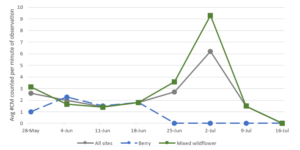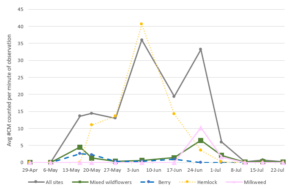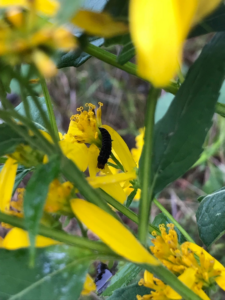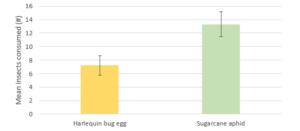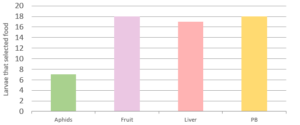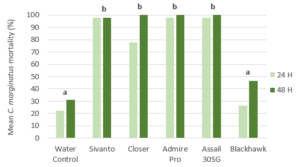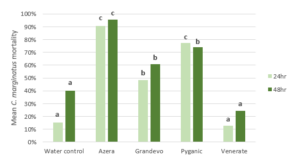Final report for GS18-188
Project Information
Chauliognathus pensylvanicus (De Geer) and C. marginatus (Fabr.) are two of the most common species of cantharid beetles observed in agroecosystems in Virginia. Despite their regional abundance and early recognition and description in the 1700s, little is known about their life cycles and ecological role in agricultural systems. Immatures are generalist predators and have been recorded feeding upon soft-bodied insects such as lepidopteran larvae. Adults are attracted to and frequently visit flowering plants, where they eat nectar and/or pollen. Beyond those observations, little is known about these species. Because of their gravitation to flowering plants as adults and predatory behaviors as larvae, there is great potential to attract adults to an agricultural area with specifically planted flowers, provide choice habitat for egg laying in nearby crop plots, and encourage larvae to feed upon a wide variety of insect pests. To determine whether larval predation by Chauliognathus spp. could be valuable in an integrated pest management context, we sought to characterize the phenology of Chauliognathus species, examine their interactions with prey, and evaluate their responses to common agricultural IPM practices. We found that C. marginatus adults were active from early May to July and utilized multiple floral resources as food and harborages. In contrast to all previous literature, we found larvae foraging during daylight hours and in the upper canopy of sweetcorn and wildflower plants. Larvae readily consumed multiple food sources offered to them, including aphids, harlequin bug eggs, peanut butter, fruit, and meat. Finally, high mortality rates were observed when C. marginatus adults were exposed to both conventional and organic insecticides. In summary, the role of Chauliognathus spp. larvae and adults in agroecosystems is complex and warrants further study.
Objective 1: Characterize the phenology of Chauliognathus spp. in southwest VA agricultural systems.
Objective 2: Investigate the feeding behavior of Chauliognathus spp. larvae.
Objective 3: Evaluate responses of adult beetles to commonly used insecticides.
Cooperators
Research
Materials and methods
Objective 1: Characterize the phenology of soldier beetle species in southwest VA agricultural systems.
Adult sampling
Visual sampling of soldier beetles was conducted in 2018 and 2019 at Kentland Farm and Homefield Farm in Whitethorne, VA. Kentland Farm is a Virginia Tech research facility that contains experimental dairy, row crop, vegetable, tree fruit, berry, forage, and other agricultural research plots. Neighboring Homefield Farm provides organically grown vegetables to Virginia Tech dining services and hosts row crop, wildflower, and vegetable research plots. C. marginatus adults had been observed aggregating on the mixed wildflowers and in the berry plots of both Kentland Farm and Homefield Farm, so those location types were selected for population monitoring in the 2018 growing season.
Sampling began when the first adult C. marginatus beetle was observed on May 28. From May 29, 2018 to July 19, 2018, samples were taken visually by walking along the margins of mixed wildflower or berry plots at approximately 0.2 m/s. All adult beetles present along a transect were counted for one minute and recorded. Five counts were taken at each site each week. Count transects did not overlap. Sampling ended when beetles were not observed for two consecutive weeks.
Results from the 2018 season informed sampling in 2019. Sampling began a full month earlier, and anecdotal observations of beetle activity on other plants indicated a wider variety of location types was necessary for adequate population monitoring. From April 29, 2019 to July 24, 2020, visual sampling procedures were repeated in four varieties of plant plots (mixed wildflower, berry, hemlock [Conium maculatum], and milkweed). Sampling ended when beetles were not observed for two consecutive weeks.
Larval sampling
To sample larval phenology, pitfall traps and clear sticky cards were deployed in August of 2018. Pitfall traps were placed at the end of a strip of plastic flashing inserted perpendicular to the ground surface to intercept ground-dwelling insects and direct them into the traps. Sticky cards were baited with egg masses of Colorado potato beetle or harlequin bug and placed at ground level to intercept ground-dwelling insects. Cards and traps were checked twice weekly for four weeks. Additionally, Reitter-Winkler samples were taken of the leaf litter/topsoil in potato, corn, and pumpkin plots. Two grids of pitfall traps were deployed in October of 2019. Nine evenly-spaced traps were placed in a 3m by 3m grid in a wildflower plot and in a field of sweetcorn refuse. Traps were checked monthly from October 2019 to February 2020.
Objective 2: Investigate the feeding behavior of Chauliognathus spp. larvae.
Predatory potential of larvae
Determining the rate at which C. marginatus larvae eat pest insects is critical for evaluating the pest control potential of these species. Two types of prey items, harlequin bug eggs and sugarcane aphids, were opportunistically collected from vegetable plots at Kentland Farm. C. marginatus larvae were collected from wingstem plants in September of 2018 and food was withheld for 24 hours. One starved C. marginatus larva was placed in a Petri dish filled with moist soil and was offered enumerated prey items before nightfall. After 12 hours, the number of prey items eaten per larva was totaled. This was repeated ten times per prey type.
To determine nutritional preferences of larval Chauliognathus beetles, a laboratory choice assay was performed. Larvae were collected from wingstem plants in September 2018 and food was withheld for 24 hours. Four food items were offered: peanut butter (vegetarian protein source with no added sugar), sugarcane aphids (hypothetical natural play), raw cow liver (animal protein source and used for rearing by Burl Stugard in the 1930s), and watermelon (high water and sugar content). After sundown, a single larva was placed in the center of a 9-cm diameter Petri dish with the four food items evenly spaced around the dish. Larvae were allowed five minutes to choose a food source and the assay was halted when a choice was made. This was repeated with 64 total larvae.
Objective 3: Evaluate responses of adult beetles to commonly used insecticides.
Adult soldier beetles in agroecosystems will likely be exposed to drift or accidental application of commonly used insecticides. To determine the effects of this exposure on adult beetles, bioassays were completed using common conventional (2019) and organic (2020) chemistries.
In June of 2019, adult C. marginatus beetles and flower sprigs were collected from wild hemlock (Conium maculatum) at Kentland Research Farm in Whitethorne, Virginia. Three 10 cm-long hemlock sprigs were dipped into 500 mL of an insecticide solution that matched a spray tank concentration of the recommended per-acre field rate assuming 30 gallon per acre output. Treated sprigs were dried for approximately 30 minutes under a fume hood, inserted into a cube of water-saturated floral foam, and placed upright in a 475 mL deli cup. This was repeated for five replicates of each treatment. Treatments included five selective insecticides commonly used in vegetable production: Sivanto (flupyradifurone), Closer (sulfoxaflor), Admire Pro (imidacloprid), Assail (acetamiprid), Blackhawk (spinosad), and a water-only control. Nine beetles were confined in each deli cup and held at laboratory ambient light and temperature for two days. At 24 and 48 hours after treatment, beetle mortality was determined by prodding each insect and observing for movement. Mortality data were analyzed with ANOVA and means separated with Tukey’s HSD.
In 2020, a similar insecticide bioassay was conducted with common insecticides used in organic agriculture. Treatments included: Azera (azadirachtin and pyrethrins), Grandevo (Chromobacterium subtsugae), Pyganic (pyrethrins), Venerate (Burkholderia spp. strain A396), and a water-only control. Mortality data were analyzed with Pearson’s chi-squared test and means separated with pairwise tests of independence. P-values were adjusted with the Bonferroni correction.
Results and discussion
Objective 1: Characterize the phenology of soldier beetle species in southwest VA agricultural systems.
Adult sampling
Average numbers of beetles counted per minute of observation were calculated for each site and plotted by year (Figure 1, Figure 2).
Fig 1: Average number of C. marginatus adults observed per 1 min visual observation while walking 0.2 m/sec at berry and wildflower plots in Southwestern VA, 2018.
Fig 2: Average number of C. marginatus adults observed per 1 min visual observation while walking 0.2 m/sec at berry, mixed wildflower, hemlock, and milkweed plots in Southwestern VA, 2019.
In 2018, C. marginatus populations peaked in early July, however, a declining trend at the start of our sampling period indicates that early seasonal activity was missed in this year. Sampling began a full month earlier in 2019, and two peaks were observed – a first, large population spike in early June, and a second, smaller peak in late June, with numbers similar to those seen in July of 2018.
In this agroecosystem, wildflower and berry blooms seem to be an important early-season source of food and harborage for C. marginatus, while hemlock is the most utilized resource midseason. Once the hemlock peaks, nectar production ceases, and the plant begins desiccating, the beetles move to mixed wildflower and milkweed patches, where they remain until those resources decline and C. marginatus’ adult activity ends for the year.
Larval sampling
Despite the variety of sampling techniques used in 2018, 2019, and 2020, larval abundance could never be consistently tracked. However, many (>200) C. marginatus larvae were observed on plants in blooming wingstem (Verbesina alternifolia) in a meadow in September 2018 (Figure 3). Additionally, in the previous summer (2017), C. marginatus larvae were observed commonly in sweetcorn ears at Kentland Farm throughout August. There is no record in the literature of Chauliognathus larvae being active during the day or leaving the ground surface for any reason. This is the first record of Chauliognathus larval activity in the canopy of wildflowers or sweetcorn during the day.
Fig 3: C. marginatus larva in the bloom of a wingstem plant. Photo from Sept 2018.
Objective 2: Investigate the feeding behavior of Chauliognathus spp. larvae.
Predatory potential of larvae
Larvae ate an average of 7 harlequin bug eggs and 13 sugarcane aphids in a 12-hour period (Figure 4). These results show that C. marginatus will attack and consume insects ranging from hard-shelled stink bug egg masses to soft-bodied aphids.
Fig. 4: Average number of harlequin bug eggs or sugarcane aphids consumed by a
C. marginatus larva in a 12-hour period. Error bars represent standard error of the mean.
When presented with four food options, most larvae did not select the food item closest to them or even immediately choose, but circled the assay arena multiple times before making a choice of which item to consume. A Pearson’s chi-square test found that the distribution of selected items was not significantly different from a hypothetical even distribution, indicating that the larvae did not show significant preference for any one of the four food items (Figure 5, Χ2 [3, N = 60] = 5.7, P = 0.125). This unexpected result indicates that further study of larval Chauliognathus food preferences is warranted.
Fig. 5: Food items selected by C. marginatus larvae. Aphids, watermelon, cow liver, and peanut butter were all selected at statistically even frequencies. Four larvae failed to make a choice in the 5-minute trial and were excluded from the analysis.
Objective 3: Evaluate responses of adult beetles to commonly used insecticides.
In the 2019 bioassay assessing conventional insecticides, C. marginatus mortality in all treatments was higher than 20%, but Sivanto, Closer, Admire Pro, and Assail caused significantly higher mortality than Blackhawk or the water-only control. There was no significant difference between mortality in the water-only control and the Blackhawk treatment (Figure 6). In summary, these beetles are highly sensitive to four of the five common vegetable insecticides evaluated in this bioassay.
Fig. 6: Mean C. marginatus mortality after 24 and 48 hours of exposure to five synthetic insecticides. Treatments headed by the same letter are not significantly different (P>0.05, Tukey’s HSD) for either the 24- or 48-hour time point.
In the 2020 bioassay assessing organic insecticides, mortality was greater than 10% in all treatments, including the control. Mortality in the Venerate treatment (13-25%) did not differ significantly from control mortality (15-40%) at 24 or 48 h. Mortality was highest in the Azera treatment (90-96%) at both 24 and 48 hr. Mortality in the Grandevo and Pyganic treatments was significantly higher than the control mortality and was lower than Azera mortality (Figure 7). In summary, C. marginatus adults were susceptible to three of the four organic insecticides. To our knowledge, these are the only published data concerning the nontarget effects of insecticides on Chauliognathus beetles.
Fig. 7: Mean C. marginatus mortality after 24 and 48 hours of exposure to four organic insecticides. Treatments headed by the same letter are not significantly different (P>0.05, pairwise tests of independence).
Educational & Outreach Activities
Participation Summary:
Editor-reviewed publications
Catron, K. A. and T. P. Kuhar. 2020. Effects of Organic Insecticide Treatments on Soldier Beetle Adults, 2020. Arthropod Management Tests. In prep.
Catron, K. A. and T. P. Kuhar. 2019. Effects of Insecticide Treatments on Soldier Beetle Adults, 2020. Ed: M. Brown. Arthropod Management Tests (45):1 https://doi.org/10.1093/amt/tsz094
Catron, K. A., C. Philips, E. Fread, and T. P. Kuhar. 2019. Soldier Beetles (Leatherwings). Virginia Cooperative Extension Publication ENTO-53NP.
Presentations at regional, national, and international conferences/meetings
Catron, K.A. 2020. Soldier Beetles: Better than TV? Virginia Tech Annual Nutshell Games, held virtually.
Catron, K.A., D. Wilczeck, and T. P. Kuhar. 2020. Patterns in diurnal host plant utilization by Chauliognathus marginatus. Entomological Society of America Annual Meeting, held virtually.
Catron, K.A. 2019. The BUZZ about pollinators: more than just honey bees! Entomological Society of America Annual Meeting, St. Louis MO. Infographic poster, now used for outreach activities
Catron, K.A. and T. P. Kuhar. 2019. Margined leatherwing (Coleoptera: Cantharidae) behavior and activity throughout daylong observation periods. Virginia Academy of Sciences Annual Meeting, Norfolk VA.
Catron, K.A. and T. P. Kuhar. 2019. Host plant utilization by Chauliognathus spp. (Coleoptera: Cantharidae) in the Eastern United States. Entomological Society of America Eastern Branch Annual Meeting, Blacksburg VA.
Catron, K. A. and T. P. Kuhar. 2018. Phenology and predatory behaviors of soldier beetles (Chauliognathus spp.) in agricultural systems. Entomological Society of America Annual Meeting, Vancouver BC.
Catron, K. A. and T. P. Kuhar. 2018. Do soldier beetles (Chauliognathus spp.) have a role in the battle against agricultural pests? Entomological Society of America Annual Meeting, Vancouver BC.
Educational Outreach
October 2020 – Provided digital content for the Virtual Hokie BugFest Pollination Station, included information on non-bee pollinators and Chauliognathus adults
October 2020 – Created the Agricultural IPM exhibit for Virtual Hokie BugFest (3,000 unique website views); communicated the role of entomologists in agriculture and designed at-home insect-themed games, educational activities, and a virtual farm tour for children and their parents
June 2020 – Led 17 2nd grade students in a virtual exploration of what makes a good pollinator via Skype a Scientist program
August 2019 – Spoke about Cantharids and non-bee pollinators at Homefield Farm Field Day (80 attendees)
October 2019 – Led the Agricultural IPM exhibit for Hokie BugFest (10,000 attendees); communicated the role of entomologists in agriculture and orchestrated insect-themed games, educational activities, and learning stations for children and their parents; answered questions about IPM, vegetable and home pests, and general agriculture
May 2019 – Led three classrooms of 20 1st grade students in a “naturalist walk” around the Price’s Fork Elementary School courtyard to identify and discuss the arthropods present
April 2019 – Designed and led a custom, daylong curriculum for 10 5th grade students, including a behavioral ecology experiment, insect poems and illustrations, and an interactive outdoor game
March 2019 – Served as an “entomology expert” for several troops of Girl Scouts (25 2nd-3rd graders) learning about insects; spoke with the girls about careers in entomology, the importance of entomologists to protecting our food supply and health, and what entomologists actually do
October 2018 – Led the Agricultural IPM exhibit for Hokie BugFest (8,500 attendees); communicated the role of entomologists in agriculture and orchestrated insect-themed games, educational activities, and learning stations for children and their parents; answered questions about IPM, vegetable and home pests, and general agriculture
Project Outcomes
There is still so much left to learn about Cantharids that I feel unable to address this question. However, I do feel that we laid the groundwork for future research that will be able to do so.
From inception to completion, I was shocked by the complexity of ecological interactions we intended to study. I set out to answer the question "can cantharid larvae be utilized as a beneficial predatory insect in agroecosystems?" but have truly only begun to scratch the surface of the answer. There is so much more at play than simply manipulating one species. Having a charismatic and abundant study subject has made it easy to explain the importance of non-bee pollinators to growers and the public, which gives me hope for future sustainable agriculture change. Overall, I was humbled by this project, but inspired to continue to create sustainable change.
I am truly grateful for the opportunity I had to study this fascinating insect. There is much more left to learn about them, including adult diet, larval behavior, larval diet, larval phenology, and impact on current agricultural systems. I hope that others can use the information we have gathered to inform future research and come closer to determining if these insects can actually help growers with insect pest control.
